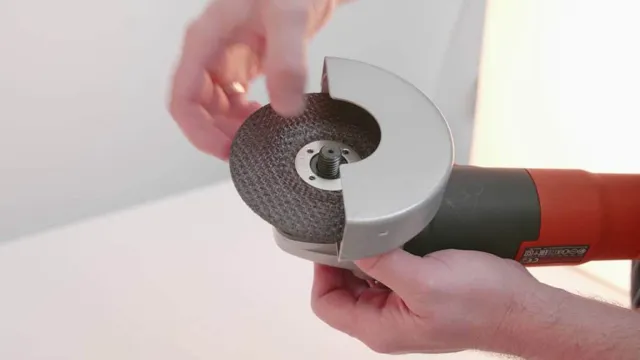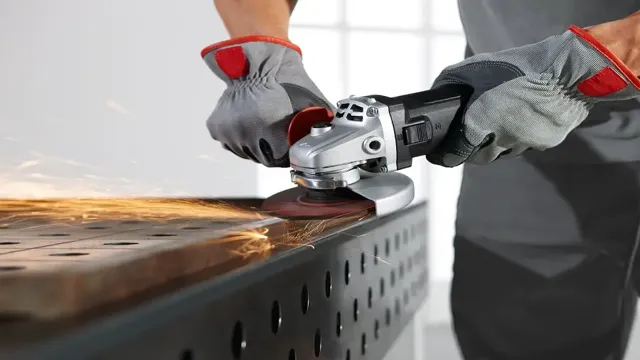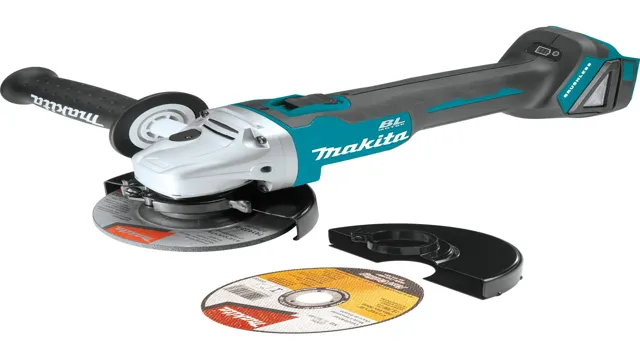How to Cut Porcelain Tile with Angle Grinder: Step-by-Step Guide for Precision Cuts

If you’re planning to renovate your kitchen or bathroom, porcelain tiles can be a fantastic choice for flooring or wall coverings. However, cutting these tiles can be a challenging task if you don’t have the right tools. Angle grinders are typically the best option for cutting porcelain tiles due to their versatility and ease of use.
But, how to cut porcelain tile with angle grinder? This article will guide you through the steps to ensure that you can cut porcelain tiles safely and accurately with an angle grinder. So, let’s dive in and learn the techniques to make your project a success!
Overview
Cutting porcelain tiles can be challenging if you’re not equipped with the right tools and knowledge. One of the best options to cut porcelain tiles is angle grinders, as they’re versatile and deliver precise cuts. However, operating an angle grinder can be dangerous, so it’s crucial to follow safety precautions.
Before starting, make sure that you’re wearing protective gear, and the porcelain tile is secured. Start by setting the angle grinder to the appropriate RPM range and selecting the correct blade. Next, start cutting, ensuring that the blade is at a 90-degree angle and making small cuts until complete, and be sure to clean the tiles after cutting.
Cutting porcelain tiles with an angle grinder may seem intricate, but with the right steps, you’ll be able to achieve accurate cuts without breaking or chipping the tiles.
What is Porcelain Tile?
Porcelain tile is a type of ceramic tile that is made from a mixture of clay and other materials, which is then fired at a high temperature to create a hard, dense surface. This construction process gives porcelain tile a number of unique characteristics that set it apart from other tile materials. Firstly, it is extremely hard and durable, able to withstand heavy foot traffic and many years of use without showing signs of wear and tear.
Secondly, it is highly resistant to stains, scratches, and moisture, making it an ideal choice for high-traffic areas of the home, including kitchens and bathrooms. Lastly, porcelain tiles come in a wide range of colors, textures, and designs, making it easy to find a style that suits your home decor. Whether you prefer a natural stone look or a clean, modern finish, porcelain tile is a versatile and long-lasting choice for any home improvement project.

What is an Angle Grinder?
An angle grinder is a versatile power tool used for cutting, grinding, and polishing a wide range of materials including metal, wood, and concrete. Its design consists of a motor that powers a spinning abrasive disc or wheel. The size of the disc or wheel can vary depending on the intended purpose, with smaller discs being used for precision work and larger ones for heavy-duty applications.
Angle grinders can be operated either with a cord or without one, known as a cordless angle grinder. They are commonly used in construction, metalworking, and woodworking industries. One of the key features of an angle grinder is its ability to change the angle of the spinning disc or wheel, giving it the flexibility to handle a variety of tasks.
In addition to cutting and grinding, angle grinders can also be used for sanding, buffing, and even polishing. However, it’s important to note that this tool requires proper safety precautions and technique. Personal protective equipment, such as safety glasses and gloves, should always be worn when operating an angle grinder.
It’s also crucial to make sure the disc or wheel is compatible with the machine and to follow the manufacturer’s instructions carefully. Overall, an angle grinder is a powerful and versatile tool that can be a valuable addition to any workshop or job site.
Safety Measures
When it comes to cutting porcelain tile with an angle grinder, safety should always be your top priority. You want to ensure that you’re not only protecting yourself from potential injuries, but also preserving the integrity of your project. First and foremost, wear protective gear, such as safety glasses, a dust mask, and gloves, to prevent any debris or dust from coming into contact with your eyes or skin.
It is also important to make sure your angle grinder is equipped with a diamond blade designed for porcelain tile cutting. As a tip, mark the area to be cut with a pencil or tape to help guide your hand. Finally, hold the grinder tightly and maintain a steady grip as you cut through the tile, keeping the blade parallel to the surface.
By following these safety measures, you can confidently and safely cut porcelain tile with an angle grinder.
Protective Clothing and Equipment
Safety Measures for Protective Clothing and Equipment When it comes to working in hazardous or risky environments, safety should always be our top priority. Protective clothing and equipment are crucial safeguards that can help prevent accidents and injuries in industries such as construction, manufacturing, and healthcare. These safety measures can include hard hats, eyewear, gloves, respirators, and high-visibility clothing.
Each type of protective gear is designed to keep workers safe and reduce the risk of injuries and illnesses caused by exposure to harmful substances, hazardous materials, or physical hazards. For instance, a hard hat or a safety helmet protects the head from falling objects, electric shocks, and other accidents. Similarly, safety glasses or goggles can shield the eyes from debris, chemicals, and high-velocity projectiles.
Gloves and other hand protection devices can prevent cuts, punctures, and chemical burns. Respirators can provide clean air and filter out harmful particles and vapors. High-visibility clothing can help workers be seen and avoid accidents in low-light or high-traffic situations.
It is important to note that the effectiveness of protective clothing and equipment depends on proper use and maintenance. Workers should be trained on how to wear and remove gear correctly, clean and disinfect it, and replace it when worn or damaged. Safety gear should also be inspected regularly to ensure that it meets safety standards and complies with regulations.
In conclusion, protective clothing and equipment are essential safety measures for preventing workplace injuries and illnesses. By investing in the right gear, training workers on safe practices, and maintaining equipment properly, organizations can create a safe and healthy work environment and protect their most valuable asset, their employees. Safety should always be a top priority, and it is something that should never be taken for granted.
Secure the Porcelain Tile
When it comes to porcelain tile, safety measures are crucial to ensure a secure and stable installation. Begin by preparing the surface properly, ensuring it is level, clean and free of debris. This will provide a sturdy base for the tile and prevent slippage or accidents.
Additionally, it’s important to have the right tools and equipment, such as safety gloves, eye protection, and knee pads, to avoid injury during the installation process. When cutting or trimming tiles, take precautions to avoid unnecessary accidents by using a score and snap cutter or wet saw. It’s equally important to make sure the adhesive is evenly spread and applied to avoid any air pockets that could cause tiles to give way or break off.
Overall, taking necessary precautions and following safety protocols will ensure a smooth and secure porcelain tile installation for a strong and long-lasting floor.
Use Proper Angle Grinder Attachments
Angle grinder attachments are essential tools in metalworking and construction. However, they can also pose significant risks, especially when used improperly. Whether you are a seasoned worker or a beginner, you must prioritize your safety by following some guidelines.
Firstly, always wear protective gear such as gloves, safety glasses, and earplugs. Secondly, choose the proper attachment for your job. Using the wrong blade can result in serious injury, so make sure to read the manufacturer’s instructions and follow them carefully.
Lastly, never force your attachment to cut through materials quickly. Doing so can cause the blade to break or kickback, which can cause severe harm. Instead, let the attachment work at its own pace, and you will have smooth and easy cuts.
Remember, safety comes first, and using proper angle grinder attachments can make your work much easier and safer.
Cutting the Porcelain Tile
Are you looking to renovate your floors and have decided on porcelain tiles? Cutting porcelain tile may seem challenging, but it can be done with an angle grinder. The first step is to prepare the tile by marking the area where you need to cut it. Then, equip the angle grinder with a diamond blade suitable for cutting porcelain.
Make sure the tile is firmly in place before turning on the grinder and ensuring that the blade is parallel to the marked line. Slowly grind down the tile, remembering to cool it with water intermittently. It may take multiple passes to cut through, but with patience, you will get a clean, precise cut.
Remember to wear protective gear, such as goggles and earplugs, to stay safe. By following these steps, you can get the perfect cut for your porcelain tile.
Start Slowly
Before diving into cutting porcelain tiles, it’s important to start slowly and ensure the proper tools and techniques are used. Porcelain tile is a dense and brittle material, making it challenging to cut without the right equipment. A diamond blade wet saw is recommended for clean and precise cuts.
It’s crucial to mark the tile beforehand with a pencil or marker to guide the saw’s path. When cutting, allow the blade to work at a natural pace to avoid cracking or chipping the tile. Remember, it’s better to make multiple passes than to force the blade through the tile.
Patience and a steady hand are key when cutting porcelain tile. By taking the time to do it correctly, you’ll achieve the perfect cut without any damage to your tile.
Apply Gradual Pressure
Cutting porcelain tiles can be a daunting task, but with gradual pressure, it is possible to make clean cuts. Porcelain tiles are hard and brittle, which makes them prone to cracking and breaking during the cutting process. To avoid this, it is advisable to use a tile cutter or a diamond blade saw.
Place the tile on the cutter bed, align the cutting line with the blade, and apply gradual pressure as you run the blade across the tile. This technique ensures that the tile does not crack or break, and you get a clean cut. It is also essential to use proper safety equipment, such as goggles and a dust mask as porcelain tiles produce a lot of dust.
With a little patience and the right tools, you can make precise cuts on porcelain tiles for your next project, whether it is a kitchen backsplash or a bathroom floor.
Use Proper Technique
When it comes to cutting porcelain tiles, it’s essential to use proper techniques to ensure a clean, precise cut. One important technique is to use a tile cutter or wet saw with a diamond blade designed specifically for cutting porcelain. These tools help ensure that the tile doesn’t crack or chip during the cutting process.
Another crucial technique to keep in mind is to use a steady hand and consistent pressure when making the cut. It’s also important to score the surface of the tile before making the cut to create an indentation that will help guide the blade. It’s worth noting that cutting porcelain tiles can be a challenging task, especially for beginners.
If you’re new to tile cutting or aren’t confident in your abilities, it may be best to seek the help of a professional. In summary, using proper technique when cutting porcelain tiles is key to achieving a clean, precise cut without damaging the tile. Remember to take your time, use the right tools, and seek professional help if necessary.
By following these tips, you’ll be well on your way to successfully cutting porcelain tiles for your next DIY project.
Finishing Touches
Cutting porcelain tiles with an angle grinder doesn’t have to be a daunting task. To get started, make sure you have the right blade equipped for the job. A diamond-tipped blade is the best choice for cutting through porcelain, as it can cleanly cut through tough materials without chipping or cracking them.
Once you have the blade set up, take your time when making cuts, and be sure to keep a firm grip on the tile while working. Consider using a guide rail to help you make straight and precise cuts. After your cuts are complete, use a sanding or grinding attachment to smooth out any rough edges or imperfections.
With these finishing touches, your porcelain tile project will look clean and professional.
Remove any Rough Edges
When it comes to finishing a project, one of the most important steps is removing any rough edges. This step might seem small, but it can really make a big impact on the final product. Rough edges can make a project look unfinished and unprofessional.
They can be distracting to the eye and make the overall appearance messy. Removing rough edges is a simple process that can be done with a variety of tools such as sandpaper, files, or even a knife. Taking the time to smooth out rough edges will ensure that your project looks polished and complete.
Plus, you’ll feel more confident presenting your work to others knowing that every detail has been attended to. So don’t overlook this important step, give your project the finishing touch it deserves by removing any rough edges.
Clean the Porcelain Tile
After you’ve thoroughly cleaned your porcelain tile, it’s important to give it some finishing touches to really make it shine. One of the best ways to do this is to give it a final rinse with clean water and then dry it off completely. This not only helps to remove any remaining dirt or soap residue, but it also helps to prevent water spots from forming.
Another great tip is to apply a sealer to the tile. This will help to protect it from stains and make it easier to clean in the future. When applying the sealer, make sure to follow the manufacturer’s instructions carefully.
Finally, consider adding a decorative element such as a colorful area rug or a few potted plants to really make your porcelain tile pop. With these finishing touches, your tile will look clean, polished, and beautiful for years to come.
Conclusion
In conclusion, cutting porcelain tile with an angle grinder may seem like a daunting task. But with the right tools, technique, and a bit of patience, you can turn any slab into a work of art. Just remember to wear protective gear, keep the blade well lubricated, and don’t forget to let your creativity shine through.
With these tips in mind, you’ll be cutting through porcelain tile like a pro in no time. And who knows, you may even impress yourself with your newfound skills and creativity! Remember, whether you’re a DIY enthusiast or a professional contractor, the possibilities are endless when it comes to cutting porcelain tile with an angle grinder.”
FAQs
What safety measures should I take before cutting porcelain tile with an angle grinder?
Before cutting porcelain tile with an angle grinder, ensure that you wear protective gear, such as goggles, a mask, and gloves. Make sure the workspace is clean and uncluttered to prevent accidents.
Can you cut porcelain tile without a wet saw?
Yes, you can cut porcelain tile using an angle grinder with a diamond blade.
What size blade is best for cutting porcelain tile with an angle grinder?
A 4-inch diamond blade is suitable for cutting porcelain tiles with an angle grinder.
Can I use a regular blade on an angle grinder to cut porcelain tile?
No, you should not use a regular blade on an angle grinder to cut porcelain tile. Only diamond blades should be used for cutting porcelain tile.
Can I make curved cuts on porcelain tile using an angle grinder?
Yes, you can make curved cuts on porcelain tile using an angle grinder, but it requires practice and skill.
How do I ensure straight cuts on porcelain tile with an angle grinder?
To ensure straight cuts on porcelain tile with an angle grinder, use a straight edge or level as a guide. This will help you make accurate cuts.
What is the best way to avoid chipping while cutting porcelain tile with an angle grinder?
To avoid chipping while cutting porcelain tile with an angle grinder, start with shallow cuts and gradually deepen them. Also, make sure the diamond blade is sharp and avoid applying too much pressure.



